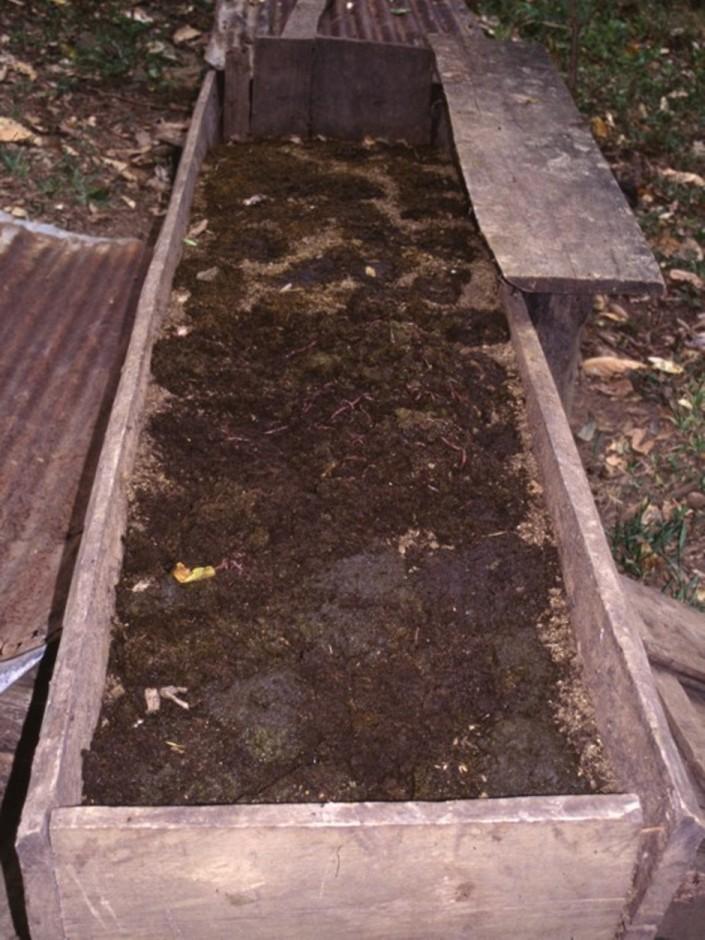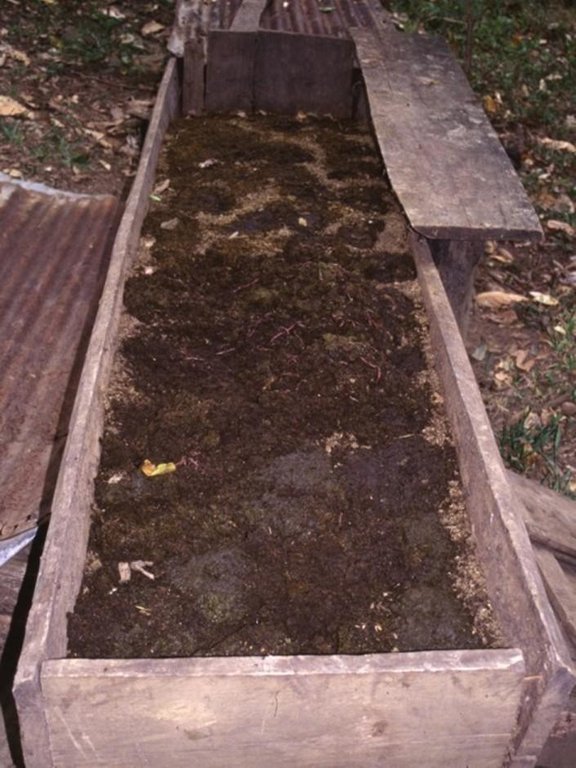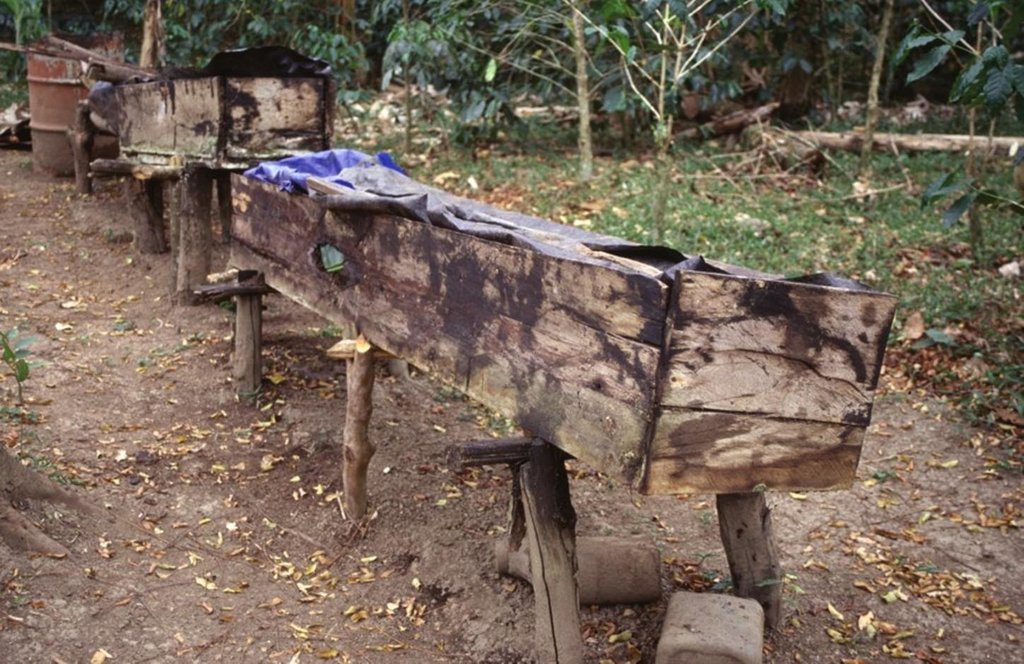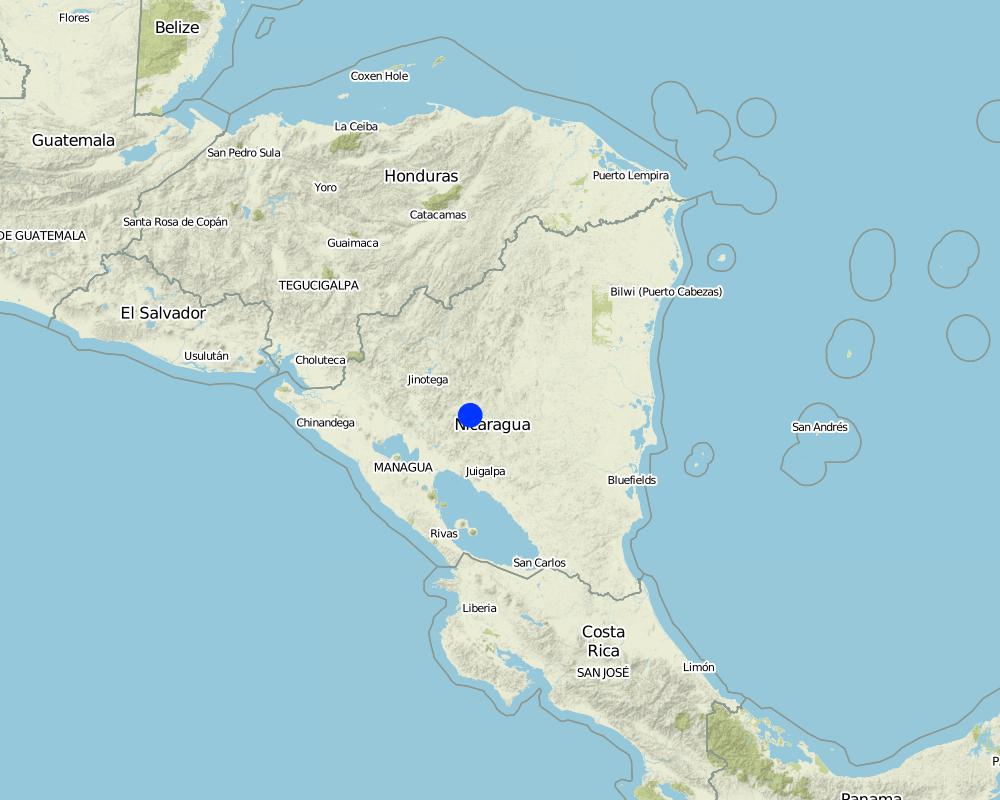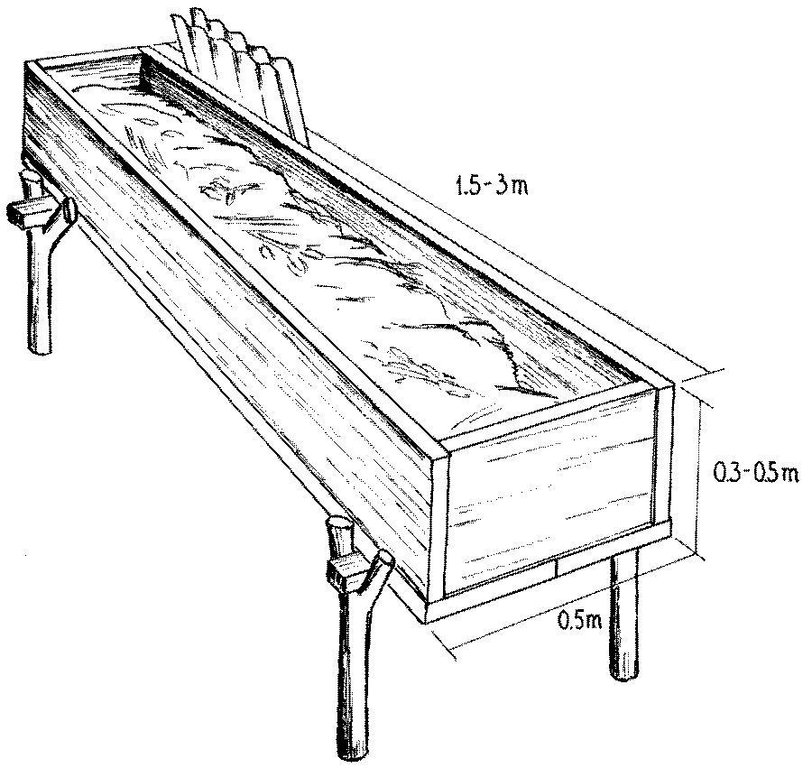Vermiculture [Никарагуа]
- Создание:
- Обновить:
- Составитель: Ramén Ernesto Caceres Ordonez
- Редактор: –
- Рецензенты: Deborah Niggli, Alexandra Gavilano
Lombricultura
technologies_1022 - Никарагуа
Просмотреть разделы
Развернуть все Свернуть все1. Общая информация
1.2 Контактные данные специалистов и организаций, участвующих в описании и оценке Технологии
Специалист по УЗП:
Gómez Martínez Julio César
De ENITEL
Никарагуа
Название проекта, содействовавшего документированию/оценке Технологии (если применимо)
Book project: where the land is greener - Case Studies and Analysis of Soil and Water Conservation Initiatives Worldwide (where the land is greener)1.3 Условия, регламентирующие использование данных, собранных ВОКАТ
Составитель и ответственный(-ые) специалист(-ы) согласны с условиями, регламентирующими использование собранных ВОКАТ данных:
Да
1.4 Декларация по устойчивости описываемой Технологии
Вызывает ли описанная здесь Технология проблемы деградации земель настолько, что ее нельзя назвать природосберегающей?
Нет
1.5 Ссылка на Анкету (ы) по Подходам УЗП (документируется с использованием ВОКАТ)

Productive development and food security programme [Никарагуа]
An integrated programme-based approach promoting participatory testing and extension of various SWC technologies, as well as providing institutional support.
- Составитель: Philippe Zahner
2. Описание Технологии УЗП
2.1 Краткое описание Технологии
Определение Технологии:
Continuous breeding of earthworms in boxes for production of high quality organic compost.
2.2 Подробное описание Технологии
Описание:
Vermiculture is a simple and cheap way to produce a continuous supply of organic compost of high quality. Eisenia foetida, the Red Californian earthworm (also called ‘the red wiggler’) is ideal for vermiculture since it is adapted to a wide range of environmental conditions. Under culture, the worms are kept under shade, in long wooden boxes filled with earth, cattle manure and an absorbent material (eg straw). The box is covered by sheet metal (or wood, thick plastic sheeting, or banana leaves) to protect the worms against UV radiation and birds/chickens, and also to maintain a favourably humid microclimate. Fresh cattle manure is a perfect food for the worms, but rotten coffee pulp can also be fed. Chopped crop residues (eg cowpeas, leucaena leaves or other legumes) may be added.
The compost produced by the earthworms has a dark colour, no smell and a loose and spongy structure. It is a high value, high quality product which is very rich in nutrients, and in a form that makes them readily available to vegetation. The content of a full box can be harvested every 3-4 months, and is used for crops -mainly coffee and vegetables, but also maize and beans. It is very effective in increasing soil fertility and thus crop production. It also improves soil structure, infiltration and water storage capacity.
The compost can either be applied directly to coffee, mixing it with an equal amount of earth and applying 1 kg to each plant. Alternatively it can be sprayed: for preparation of liquid fertilizer 50 kg compost are mixed with 50 litres of water and left to soak for 5 days. The concentrated solution produced is mixed with water at a ratio of 1 to10 and applied to the crop using a knapsack sprayer. The earthworms reach their reproductive age after three months and live for many years. In perfect conditions an earthworm produces up to 1,500 offspring per year. Thanks to their rapid reproduction, new cultures can easily be established, or earthworm stocks can be sold according to the farmer’s needs. A certain amount
of earthworm compost is kept back and being used instead of fresh earth to reinitiate the whole process, or to start new cultures.
The area is characterised by humid climate, steep slopes and low soil fertility. Farmers are mainly smallholders with individual properties. Earthworm culture does not depend closely on the external environment, but it is essential to maintain favourable conditions inside the box - namely continuous feeding and wetting. That’s why it is usually recommended to keep cultures near the house and the home-garden. Ants, the main enemy of earthworms, can be controlled standing the boxes on poles in cans filled with water.
2.3 Фотографии, иллюстрирующие Технологию
2.5 Страна/ регион/ места, где применяется Технология, информация о которых собрана в данной Анкете
Страна:
Никарагуа
Административная единица (Район/Область):
Matagalpa
Более точная привязка места:
Matiguas, Pancasán
Пояснения:
Total area covered by the SLM Technology is 5 m2.
Map
×2.7 Внедрение Технологии
Укажите, как именно Технология УЗП была внедрена:
- через проекты/ внешнее вмешательство
3. Классификация Технологии УЗП
3.1 Основные цели и задачи реализации Технологии
- сохранение/ повышение биоразнообразия
3.2 Текущий(-ие) тип(-ы) землепользования на территории, где применяется Технология

Пахотные угодья и плантации
- Однолетние культуры
- Многолетние (недревесные) культуры
Число урожаев за год:
- 1
Поясните:
Longest growing period in days: 300, Longest growing period from month to month: May untill February
Пояснения:
Major land use problems (compiler’s opinion):
- low crop yields due to soil fertility decline
- water and wind erosion
- small landholdings
3.4 Водоснабжение
Обеспеченность водой участков, где реализуется Технология :
- богарные земли
3.5 Категория УЗП, к которой относится Технология
- Комплексное управление почвенным плодородием
- Пчеловодство, аквакультура, птицеводство, разведение кроликов, разведение шелкопряда и т.д.
3.6 Мероприятия УЗП, выполняемые в рамках Технологии

Агрономические мероприятия
- A4: Глубокая обработка почв
Пояснения:
Type of agronomic measures: manure / compost / residues
3.7 Основные проблемы деградации земель, на решение которых направлена Технология

ухудшение химических свойств почв
- Хп: Снижение плодородия и уменьшение содержания органического вещества (вызванное не эрозией, а другими причинами)
Пояснения:
Main causes of degradation: soil management, deforestation / removal of natural vegetation (incl. forest fires), overgrazing (on a single cattle farm), poverty / wealth (lack of capital)
Secondary causes of degradation: over-exploitation of vegetation for domestic use, other natural causes (avalanches, volcanic eruptions, mud flows, highly susceptible natural resources, extreme topography, etc.) specify (impacts of hurricane Mitch), governance / institutional (lack of strenght of law and authorities), inter-generational subdivision of land
3.8 Предотвращение и снижение деградации земель, или восстановление нарушенных земель
Укажите цель Технологии по отношению к деградации земель :
- снижение деградации земель
4. Технические характеристики, мероприятия по практической реализации, вложения и стоимость
4.1 Технический рисунок, иллюстрирующий Технологию
Спецификация (пояснения к техническому рисунку):
Detailed view of wooden box for compost production by earthworms. Cover (corrugated iron or alternative) is important to protect worms from light, from birds and other natural enemies, and to maintain moisture in the box.
Technical knowledge required for field staff / advisors: moderate
Technical knowledge required for land users: moderate
Main technical functions: increase of surface roughness, improvement of topsoil structure (compaction), increase in organic matter, increase in nutrient availability (supply, recycling,…)
Secondary technical functions: increase of infiltration
Manure / compost / residues
Material/ species: compost
Автор:
Mats Gurtner
4.4 Вложения и затраты, необходимые для начала реализации
| Опишите затраты | Единица | Количество | Затраты на единицу | Общая стоимость на единицу | % затрат, оплаченных землепользователями | |
|---|---|---|---|---|---|---|
| Оплата труда | labour | ha | 1,0 | 6,0 | 6,0 | 100,0 |
| Строительные материалы | wood | ha | 1,0 | 50,0 | 50,0 | 100,0 |
| Строительные материалы | Sheet metal, plastic | ha | 1,0 | 6,0 | 6,0 | 100,0 |
| Другие | earthworms (kg) | ha | 1,0 | 60,0 | 60,0 | |
| Общая стоимость запуска Технологии | 122,0 | |||||
| Общие затраты на создание Технологии в долларах США | 122,0 | |||||
Пояснения:
Duration of establishment phase: 0.07 month(s)
4.5 Поддержание/ текущее обслуживание
| Деятельность | Сроки/ повторяемость проведения | |
|---|---|---|
| 1. | 1. Feeding: add another layer of cattle manure(1 kg earthworms eat 1 kg manure per day). | no specific timing for maintenance / every 3–5 days |
| 2. | 2. Maintain humidity at 80%, water frequently in dry season, maintaintemperature between 15–30°C: do not exceed 42°C. | no specific timing for maintenance / frequently in dry season |
| 3. | 3.The worms migrate into the fresh manure. After 2–3 days take out thesieve and gather the ready, worm free compost. | no specific timing for maintenance / every 3–4 months |
| 4. | 4. Apply compost to the crops (1 kg/coffee plant, see description). | no specific timing for maintenance / every 3–4 months |
| 5. | 6. Possible improvement: add lime to raise pH to a optimum level of 7.0. | no specific timing for maintenance / |
4.6 Стоимость поддержания/ текущего обслуживания ( в год)
| Опишите затраты | Единица | Количество | Затраты на единицу | Общая стоимость на единицу | % затрат, оплаченных землепользователями | |
|---|---|---|---|---|---|---|
| Оплата труда | labour | ha | 1,0 | 60,0 | 60,0 | 100,0 |
| Общая стоимость поддержания Технологии | 60,0 | |||||
| Общие затраты на поддержание Технологии в долларах США | 60,0 | |||||
Пояснения:
Machinery/ tools: hammer, nails, buckets/wheelbarrow, shovel, possibly water hose, hammer, nails, buckets/wheelbarrow, shovel, possibly water hose
60% of the land users have their own cattle, others get manure free from their neighbours. The cattle manure has no commercial price in the region - there is no market for it. The inputs and costs are estimated for the production of approx. 4,000 kg of worm compost, which is enough for one hectare of coffee per year (note figures from India for vermiculture suggest higher input-output ratios: in other words less output for the same amount of input).
5. Природные и социально-экономические условия
5.1 Климат
Среднегодовое количество осадков
- < 250 мм
- 251-500 мм
- 501-750 мм
- 751-1000 мм
- 1001-1500 мм
- 1501-2000 мм
- 2001-3000 мм
- 3001-4000 мм
- > 4000 мм
Агроклиматическая зона
- влажная
- Умеренно-влажная
Thermal climate class: tropics
5.2 Рельеф
Склоны (преобладающие):
- пологие (0-2%)
- покатые (3-5%)
- покато-крутые (6-10%)
- крутые (11-15%)
- очень крутые (16-30%)
- чрезвычайно крутые (31-60%)
- обрывистые (>60%)
Формы рельефа:
- плато/ равнины
- гребни хребтов/холмов
- склоны гор
- склоны холмов
- подножья
- днища долин
Зона высотной поясности:
- 0-100 м над уровнем моря
- 101-500 м н.у.м.
- 501-1000 м н.у.м.
- 1001-1500 м н.у.м.
- 1501-2000 м н.у.м.
- 2001-2500 м н.у.м.
- 2501-3000 м н.у.м.
- 3001-4000 м н.у.м.
- > 4 тыс. м н.у.м.
5.3 Почвы
Средняя мощность почв:
- поверхностные (0-20 см)
- неглубокие (21-50 см)
- умеренно глубокие (51-80 см)
- глубокие (81-120 см)
- очень глубокие (> 120 см)
Гранулометрический состав (верхнего горизонта):
- тонкодисперсный/ тяжёлый (глинистый)
Содержание органического вещества в верхнем горизонте:
- низкое (< 1%)
5.6 Характеристика землепользователей, применяющих Технологию
Рыночная ориентация производства:
- натуральное хозяйство (самообеспечение)
- смешанный (натуральный / коммерческий)
Доходы из других источников:
- < 10% всех доходов
Укажите другие важные характеристики землепользователей:
Off-farm income specification: nearly all land users are fully occupied with agricultural activities, very few are involved in commerce or are employed
5.7 Средняя площадь земель, используемых землепользователями с применением Технологии
- < 0,5 га
- 0,5-1 га
- 1-2 га
- 2-5 га
- 5-15 га
- 15-50 га
- 50-100 га
- 100-500 га
- 500-1000 га
- 1000-10000 га
- > 10000 га
5.8 Собственность на землю, права на земле- и водопользование
Землевладелец:
- индивидуальная, не оформленная в собственность
- индивидуальная, оформленная в собственность
Право землепользования:
- аренда
- индивидуальное
6. Воздействия и заключительные положения
6.1 Влияние Технологии УЗП в пределах территории ее применения
Социально-экономическое воздействие
Продуктивность
производство сельскозяйственных культур
производство кормов
качество кормов
Доходы и затраты
доходы хозяйства
Социальное и культурное воздействие
смягчение конфликтов
Экологическое воздействие
Почвы
влажность почв
Комментарий/ пояснения:
through improvement of soil water storage capacity
Биоразнообразие: растительность, животный мир
борьба с вредителями/ болезнями
Комментарий/ пояснения:
the compost attracts pests like ants, chickens, moles
6.2 Влияние Технологии за пределами территории ее применения
загрязнение подземных/ речных вод
Комментарий/ пояснения:
lower inputs of chemical fertilizers
6.5 Внедрение Технологии
Пояснения:
88 land user families have adopted the Technology with external material support
6 land user families have adopted the Technology without any external material support
There is a little trend towards spontaneous adoption of the Technology. As ADDAC (the Association for Agricultural Community Development and Diversification) has a permanent and longterm presence in the approach area, most interested farmers are directly involved in the programme activities: this explains the fact that only 5% of the technology users (6 people) took up earthworm culture without incentives (see approach).
6.7 Сильные стороны/ преимущества/ возможности Технологии
| Сильные стороны/ преимущества/ возможности по мнению землепользователей |
|---|
| Additional economic income through commercialization of earthworm stocks |
| Health: clean products without chemical treatment. |
| Сильные стороны/ преимущества/ возможности по мнению составителя или других ключевых специалистов |
|---|
| Continuous and increasing production of organic and very effective compost with high nutrient content (replacing chemical fertilizers) |
|
Appropriate for different crops (though in different forms – direct application or spraying). |
| Simple and cheap technology; low labour input |
| Increased crop yields |
| Earthworm culture is becoming an integrated part of the production system, especially for land users who have cows. |
6.8 Слабые стороны/ недостатки/ риски Технологии и пути их преодоления
| Слабые стороны/ недостатки/ риски по мнению составителя или ответственных специалистов | Возможные пути их преодоления/снижения? |
|---|---|
| Requires permanent access to water | A close fitting and secure box cover, as well as placement of the box in the shade reduces loss of humidity. Roof-top rainwater collection helps to get over dry periods. |
| Requires continuous availability of manure to feed worms. | Improve the construction of the boxes (close holes and cover the box tightly). |
| Attracts natural enemies like ants, chickens, moles, flies; needs protection |
7. Справочные материалы и ссылки
7.1 Методы сбора/ источники информации
- выезды на места, полевые обследования
- опросы землепользователей
Когда были собраны данные (на местах)?
01/02/2004
7.2 Ссылки на опубликованные материалы
Название, автор, год публикации, ISBN:
PASOLAC. Guía Técnica de Conservación de Suelos y Agua.. 2000.
Где опубликовано? Стоимость?
PASOLAC, Managua
Название, автор, год публикации, ISBN:
Ferruzzi C. Manual de Lombricultura. Ediciones Mundi-Prensa. Madrid, Spain. 1986.
Название, автор, год публикации, ISBN:
Castillo H . La lombricultura. in Altertec. Alternativas de Mejoramiento de Suelos.Proceso de Capacitación para Profesionales. Modulo II. Altertec, Ciudad de Guatemala. 1994.
Ссылки и модули
Развернуть все Свернуть всеСсылки

Productive development and food security programme [Никарагуа]
An integrated programme-based approach promoting participatory testing and extension of various SWC technologies, as well as providing institutional support.
- Составитель: Philippe Zahner
Модули
Нет модулей


